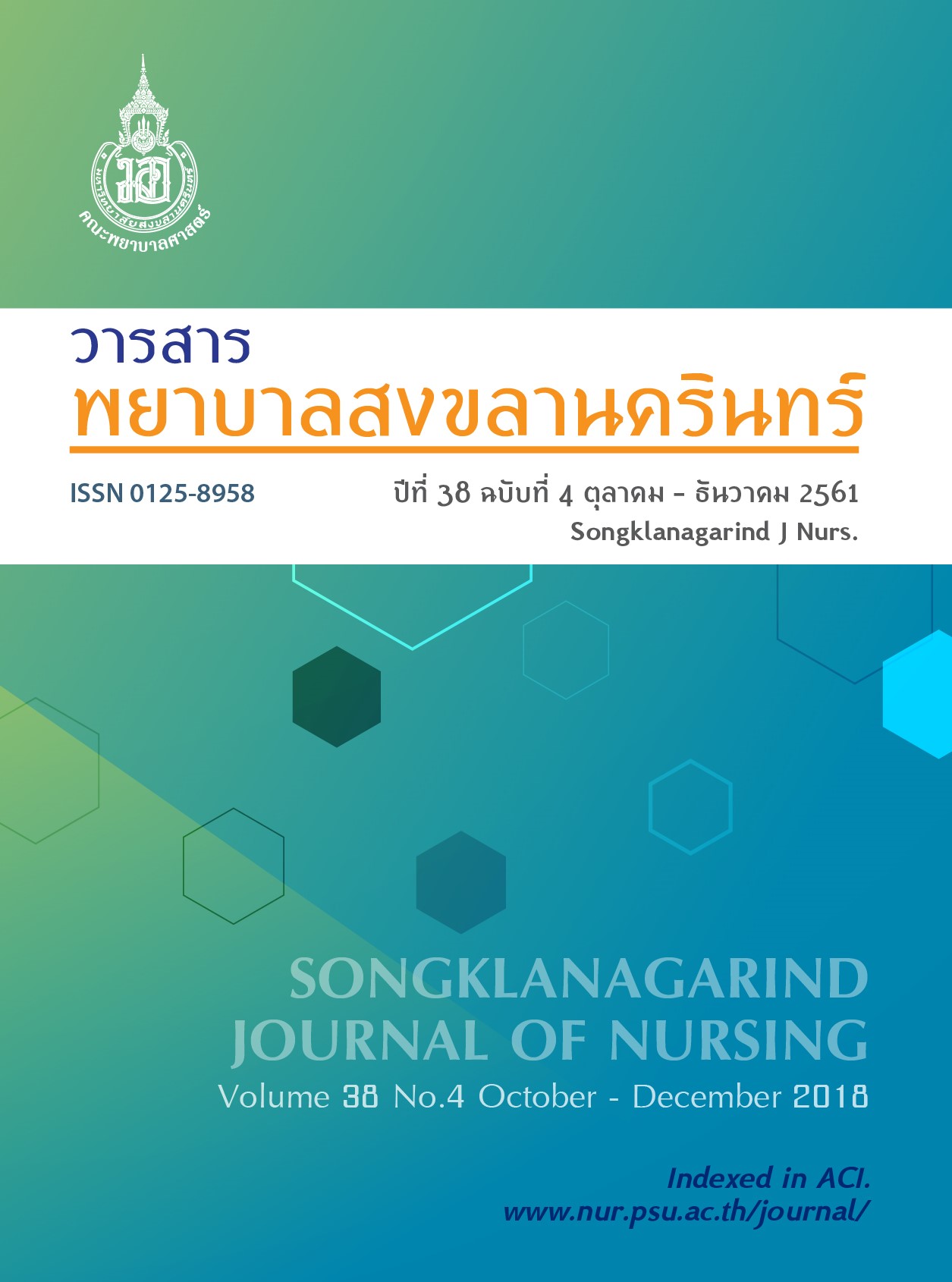ความสัมพันธ์ระหว่างความเชื่อด้านสุขภาพกับการเข้าถึง บริการสุขภาพในกลุ่มโรคไม่ติดต่อเรื้อรังของประชาชน ห้าจังหวัดชายแดนใต้ ประเทศไทย
Main Article Content
บทคัดย่อ
การวิจัยนี้เป็นการวิจัยเชิงพรรณามีวัตถุประสงค์ เพื่อศึกษาสถานการณ์โรคไม่ติดต่อเรื้อรังของประชาชนห้าจังหวัดชายแดนใต้ และหาความสัมพันธ์ระหว่างความเชื่อด้านสุขภาพ กับการเข้าถึงบริการสุขภาพของประชาชนห้าจังหวัดชายแดนใต้ การศึกษาแบ่งเป็น 2 ระยะ ระยะที่ 1 การพัฒนากรอบแนวคิด เลือกผู้ให้ข้อมูลแบบเฉพาะเจาะจง ประกอบด้วย ผู้บริหาร และเจ้าหน้าที่ในสำนักงานสาธารณสุขจังหวัดห้าจังหวัดชายแดนใต้ จำนวน 30 คน เครื่องมือการวิจัย เป็นข้อคำถามที่ผู้วิจัยสร้างขึ้น หาความเที่ยงตรงเชิงเนื้อหาจากผู้เชี่ยวชาญ 3 คน มีค่า IOC 0.8 เก็บข้อมูลเดือนกรกฎาคม 2560 ด้วยการสนทนากลุ่มวิเคราะห์ข้อมูล โดยใช้การวิเคราะห์เชิงเนื้อหา แล้วนำมาสร้างเป็นแบบสอบถาม ระยะที่ 2 การสำรวจสถานการณ์โรคไม่ติดต่อเรื้อรัง ความเชื่อด้านสุขภาพ และการเข้าถึงบริการสุขภาพ กลุ่มตัวอย่าง เป็นประชากรห้าจังหวัดชายแดนใต้ สุ่มตัวอย่างแบบแบ่งชั้น จำนวน 2,000 คน เครื่องมือการวิจัย เป็นแบบสอบถามที่ผู้วิจัยสร้างขึ้นจากกรอบแนวคิดในระยะที่ 1 มีค่าความเชื่อมั่น 0.8 เก็บข้อมูลระหว่างเดือนกันยายน - พฤศจิกายน 2560 โดยผู้วิจัยในพื้นที่ที่ได้รับการฝึกอบรม วิเคราะห์ข้อมูล โดยใช้สถิติพรรณนา ร้อยละ ค่าเฉลี่ย และค่าเบี่ยงเบนมาตรฐาน ทดสอบความสัมพันธ์ระหว่างตัวแปร ด้วยสถิติไคว์สแควร์
ผลการศึกษาในระยะที่ 1 พบว่า กรอบแนวคิดในการพัฒนา ได้แก่ ความเชื่อในการดูแลพฤติกรรมสุขภาพ พฤติกรรมบริการของเจ้าหน้าที่สาธารณสุข และระบบบริการสุขภาพ ระยะที่ 2 พบว่า สถานการณ์โรคไม่ติดต่อเรื้อรัง ได้แก่ โรคความดันโลหิตสูงมากที่สุด (ร้อยละ 30.0) รองลงมาโรคเบาหวาน (ร้อยละ 9.7) โรคหัวใจ (ร้อยละ 6.0) และโรคมะเร็ง (ร้อยละ 0.2) ตามลำดับ การรับรู้ความรุนแรงและความเสี่ยงของโรคความดันโลหิตสูง โรคเบาหวาน และหลักความเชื่อทางศาสนา มีความสัมพันธ์กับการเข้าถึงบริการสุขภาพอย่างมีนัยสำคัญทางสถิติที่ระดับ .05 ดังนั้น เจ้าหน้าที่สาธารณสุขควรส่งเสริมการรับรู้ความเสี่ยง ความรุนแรง สาเหตุของการเกิดโรค และผลกระทบที่เกิดขึ้น โดยใช้ภาษาที่ประชาชนในพื้นที่เข้าใจและส่งเสริมการมีส่วนร่วมขององค์กรศาสนา
Article Details
เอกสารอ้างอิง
2. Bureau of non communicable diseases. Strategy and planning division. 2015; Available from: http://www.thaincd.com/2016/mission3. Thai.
3. Bureau of Non Communicable Disease. Annual Report 2017. Aksorn graphic and design publishing; 2017. Thai.
4. Awaeni S, Waram M, Saridae R, et al. Health management of people in the unrest situation in the southern border provinces. Health systems research institute; 2010. Thai.
5. Jansorn A, Bumrerraj S. Health beliefs of change model in prevention of opisthorchiasis among people in Nonghukhu sub-district, Banphue district, Udon Thani Province. Community health development quarterly Khon Kaen University. 2016; 4(3). July- September: 443-457. Thai.
6. Janz N K, Becker M H. The health belief model: A decade later. Health Education & Behavior. 1984; 11(1):1-47.
7. Praiwong C, Sattayawongtip W, Seekul P. The study of health beliefs and self-care behaviors of Patients with hypertension in Sung Noen district, Nakhon Ratchasima Province. Journal of Nakhon Ratchasima colledge. 2017; 11(1): 26-36. Thai.
8. Champion V L, Skinner C S. The health belief model. health behaviour and health education; theory, research, and practice. Jossey-Bass, San Francisco.2008; 45-65.
9. Official statistics registration system. Available from http://stat.bora.dopa.go.th/stat/pk/pk_56.pdf. Data 31 December; 2013.Thai.
10. Thanwong T, Pensirinapa N, Kirapong P. Factors related to medical care usage of chronic disease patients at sub-district health promoting hospitals in Khao Yoi Health Network, Petchaburi Province. Journal of Safety and Health. 2016; 9(31): 26-36. Thai.
11. Sutheravut P. Crisis health system,3 Southern Border Provinces. Available from: https://www.gotoknow.org/posts/4396. Thai.
12. Krejcie R V, Morgan D W. Determining sample size for research activities. Educational and psychological measurement. 1970; 30(3): 607-610.
13. Tongdee J, Rongmuang D, Nakchatree C. Health status and quality of life among the elderly in the Southern Border Provinces of Thailand. Nursing journal of the ministry of public health. 2012; 22(3): 88-99. Thai.
14. Ministry of Public Health. Summary of the results of the state inspection and supervision. Available from: http://healthdata.moph.go.th/; 2017. Thai.
15. Waiyawanjit S, Makeng M, Chintara N. The way of life of the Muslim people that affects the health promotion through adequate physical activity. Research report. Physical activity research center; 2013. Thai.
16. Chareanphan T, Surinya T. Health belief, self efficacy, parenting styles and self care behavior of the high school students at Satri Nonthaburi in Nonthaburi Province. Journal of Social science and Health. 2014; 40(1): 69-84. Thai.
17. Reginal health 12. Ministry of Public Health. Available from: http://info.sasuk12.com/archives/nitate/index.html. Thai.
18. Leangpunsakul S, Lilahkul N, Sornbut J, et al. Situation and factors affecting the success of maternal and child health in 3 Southern Provinces. Health systems research institute; 2015. Thai.


